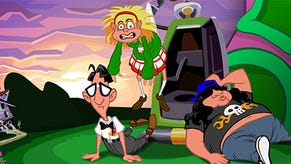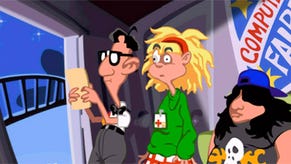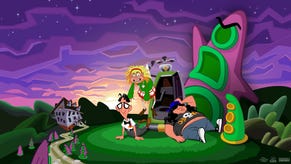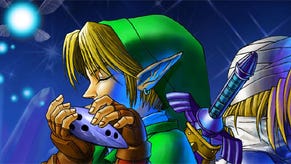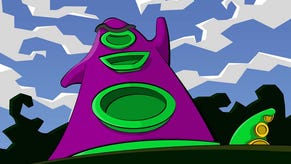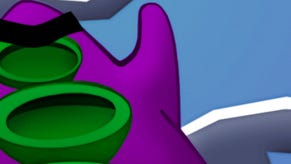Day of the Tentacle Composer Peter McConnell on Communicating Cartooniness
COVER STORY: One of DoTT's trio of musicians talks about the challenges of selling its zany atmosphere with some relatively primitive tools.
This article first appeared on USgamer, a partner publication of VG247. Some content, such as this article, has been migrated to VG247 for posterity after USgamer's closure - but it has not been edited or further vetted by the VG247 team.
USgamer: I was listening to your section of the soundtrack today, and I was wondering what your inspirations were for those pieces. I also wanted to ask about the use of leitmotifs in this game, because, they were not new to LucasArts adventure games, but I feel like they are used the most, and I feel like they have the strongest effect, in Day of the Tentacle.
The truth is, we did think about that stuff a lot. We were all schooled in that tradition. I say we were schooled in the tradition of Wagner and Looney Tunes, and how Looney Tunes parodied Wagner, Carl Stalling parodied Wagner. And, I think maybe the reason that it's extra noticeable in Day of the Tentacle was [because] with Indiana Jones, you're dealing with John Williams themes, which are wonderful, but we were trying to be true to them, so we didn't try to come up with too many new ones. And, the way you use leitmotifs is a little different in a movie than you do in the game, and with something like Monkey, which was much more thematic that way. With Monkey there were a lot of characters and they had themes, but there was this overall vibe of the reggae, pirate reggae music, that sort of was so dominant that you don't really notice that the particular melodies are, you don't quite associate them with characters as much, with a couple noticeable exceptions like the voodoo lady.
But for DoTT, it's basically all about the characters. There were a ton of really pungent, interesting... there's a whole team of kids, and each one of them are really interesting characters, and then of course you have a bad guy, and a couple bad guys, really, and both of them need themes. So, we really meant to make that pretty obvious, and that was what was fun about the score. Because the comedy's kind of slapstick, [we had] kind of over-the-top representations of that in the music, so that you always know who's talking. A lot of time we would have little hooks that would play the character's theme if that character was talking, kind of thing.
USg: I do notice a little bit more of, like, klezmer music, almost a Jewish-y affect with Bernard pieces. I don't know if that's just me reading into it, and I don't think Bernard is a Jewish character, but that—is it called klezmer music?
PM: Yeah, I'm a huge klezmer fan, and it probably is in there.
USg: Although Bernard does resemble Woody Allen a lot.
PM: Yeah, I think he's totally a Woody Allen parody, especially with the glasses. And I think his instrument is generally the clarinet, which Woody Allen plays the clarinet. And Woody Allen played all that clarinet music in Sleeper.

USg: Oh, yeah, and he would be on talk shows playing the clarinet, I think.
PM: Yeah, he's an incredible, incredible player. Really makes you want to kill yourself. So, yeah, I would say there is a little klezmer influence in there. I'm always influenced by '70s crime drama music. I was a huge fan of all those Quinn Martin shows, like Mannix and Cannon and Barnaby Jones, so I was a big Lalo Schifrin fan, so a lot of the jazz that you hear is kind of that, in a Lalo Schifrin vibe, with, there was probably a fair amount of Twilight Zone influence on Day of the Tentacle as well for me. And a little bit of Hawaii Five-O, that's also '70s crime drama. Because, I remember there was a bad guy, a particularly devious bad guy on Hawaii Five-O, who had a really great little harpsichord theme, and that may or may not be where I got the idea of Dr. Fred having a harpsichord.
USg: I did pick up on the use of some classic cartoon music in Day of the Tentacle.
PM: And that's really going to the old Looney Tunes tradition of parodying the operatic stuff. The Rabbit of Seville, and What's Opera, Doc. So, starting out with Rossini, it seemed like the obvious thing to do, we'd seen so many cartoons that start out with that piece.
USg: It really does establish the intent of the game in general.
PM: There really are two cliches you can put there. One is [sings beginning of "William Tell Overture"], that's the one that we used. And the other is [sings "Morning Mood" by Grieg], which is Grieg, I think, or Gluck. I can't remember now. Anyway, one of those G guys. So, it's the thing that's fun about it is, we did the big giant cliché. We completely ripped off ripping off. But, it was so perf—Sometimes that's the funniest thing, and it made that opening just, it set up perfectly the evil, "you must pay the rent" music for Purple Tentacle. And then there's the whole thing of, and there's a great example of how, that music is actually interactive, because that opening scene is so long that where you are in the music when the kids are at a certain point, when that car reaches a certain point on the hill, and you want a gag to happen, you want a stinger, that's completely dependent on the machine that it's playing on.
So, Clint [Bajakian] spent a good amount of time making the piece so that it could gracefully jump ahead or bide its time while the picture caught up. And so that all those gags would be assured to happen at the right time. So, to actually score it like a Carl Stalling score of a cartoon where, you're following the motion that minutely, especially, took some fancy technology, essentially accounting for the unfanciness of the underlying technology, which was not allowed to, which couldn't, wasn't streaming. It was rendering.
USg: That's incredible. So, in closing, I'd like to know what you think of this experience in retrospect, 23 years later, and how do you reflect your work on this game compared to things you made before and since?
PM: Holy crap, it's 23 years later. Oh, jeez. [laughs]
USg: Sorry for reminding you of that.
PM: OK, so, you were saying, before and since, I look at it as my introduction to how games get made. And, sort of, the whole idea of really really dedicating yourself to the best possible experience that the player's going to have, and really—You know what's great about Disneyland is, everything about it is fun. Unless it's ridiculously crowded, even waiting in line is fun. They take special, and I'm sure a lot of places have learned from this, but Disneyland is the original, right? They take special care, that if there's an opportunity anywhere in that park to make something fun, they'll go out of their way to do that. You'll look down in line, and you'll see some little thing, and you'll go, “Man, that did not have to be there, but that is really cute.”
And that's the way we were with those games. Some of that spirit, I think you could say, can get lost these days, with games the way they are now. But, I don't think altogether, and I think there are people and companies and teams that carry that sort of tradition on, where you basically don't have to, you didn't have to do that, but you did, and because you did, the player has a little smile. And, I think that's really what I learned from, and maybe from DoTT in particular, because, the writing, there was a lot of good writing in that game, and I think, just the whole idea of, you don't have to have that sixth useless response in the dialogue tree that still has a great little elbow nudging punchline, but it's so much better because you do. So, and I think we did the same thing with the music, even though, given the choice now, I will always try to do something with human beings.
Special thanks to Liz Lerner for the interview transcriptions. Original Day of the Tentacle background images courtesy of neurotech's Imgur account.
